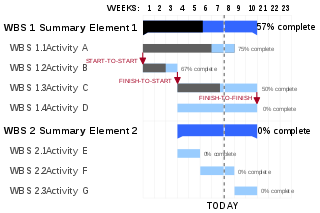Project planning is part of project management, which relates to the use of schedules such as Gantt charts to plan and subsequently report progress within the project environment.
Critical chain project management (CCPM) is a method of planning and managing projects that emphasizes the resources required to execute project tasks. It was developed by Eliyahu M. Goldratt. It differs from more traditional methods that derive from critical path and PERT algorithms, which emphasize task order and rigid scheduling. A critical chain project network strives to keep resources levelled, and requires that they be flexible in start times.

The program (or project) evaluation and review technique (PERT) is a statistical tool used in project management, which was designed to analyze and represent the tasks involved in completing a given project.

A Gantt chart is a type of bar chart that illustrates a project schedule, named after its inventor, Henry Gantt (1861–1919), who designed such a chart around the years 1910–1915. Modern Gantt charts also show the dependency relationships between activities and current schedule status.
In project management, float or slack is the amount of time that a task in a project network can be delayed without causing a delay to:
Task analysis is the analysis of how a task is accomplished, including a detailed description of both manual and mental activities, task and element durations, task frequency, task allocation, task complexity, environmental conditions, necessary clothing and equipment, and any other unique factors involved in or required for one or more people to perform a given task.
In project management, resources are required to carry out the project tasks. They can be people, equipment, facilities, funding, or anything else capable of definition required for the completion of a project activity. The lack of a resource will therefore be a constraint on the completion of the project activity. Resources may be storable or non storable. Storable resources remain available unless depleted by usage, and may be replenished by project tasks which produce them. Non-storable resources must be renewed for each time period, even if not used in previous time periods.

MacProject was a project management and scheduling business application released along with the first Apple Macintosh systems in 1984. MacProject was one of the first major business tools for the Macintosh which enabled users to calculate the "critical path" to completion and estimate costs in money and time. If a project deadline was missed or if available resources changed, MacProject recalculated everything automatically.

The precedence diagram method (PDM) is a tool for scheduling activities in a project plan. It is a method of constructing a project schedule network diagram that uses boxes, referred to as nodes, to represent activities and connects them with arrows that show the dependencies. It is also called the activity-on-node (AON) method.
Manufacturing process management (MPM) is a collection of technologies and methods used to define how products are to be manufactured. MPM differs from ERP/MRP which is used to plan the ordering of materials and other resources, set manufacturing schedules, and compile cost data.

Critical Chain is a novel by Dr. Eliyahu Goldratt using the Critical Chain theory of Project Management as the major theme. It is really a teaching method for the theory.
The Ateneo School of Government or ASoG is the graduate school of leadership and public service of the Ateneo de Manila University, a private, Roman Catholic university established by the Society of Jesus in the Philippines.
The material point method (MPM) is a numerical technique used to simulate the behavior of solids, liquids, gases, and any other continuum material. Especially, it is a robust spatial discretization method for simulating multi-phase (solid-fluid-gas) interactions. In the MPM, a continuum body is described by a number of small Lagrangian elements referred to as 'material points'. These material points are surrounded by a background mesh/grid that is used only to calculate gradient terms such as the deformation gradient. Unlike other mesh-based methods like the finite element method, finite volume method or finite difference method, the MPM is not a mesh based method and is instead categorized as a meshless/meshfree or continuum-based particle method, examples of which are smoothed particle hydrodynamics and peridynamics. Despite the presence of a background mesh, the MPM does not encounter the drawbacks of mesh-based methods which makes it a promising and powerful tool in computational mechanics.
Grand Central Dispatch (GCD) is a technology developed by Apple Inc. to optimize application support for systems with multi-core processors and other symmetric multiprocessing systems. It is an implementation of task parallelism based on the thread pool pattern. The fundamental idea is to move the management of the thread pool out of the hands of the developer, and closer to the operating system. The developer injects "work packages" into the pool oblivious of the pool's architecture. This model improves simplicity, portability and performance.

Jules-Louis-Olivier Métra, was a 19th-century French composer and conductor.
Schedule Network Analysis is a strategy that is commonly used in project management. The strategy consists of visualising the different project tasks and making connections between them in the project management plan.

Yves Eugene was a French engineer and manager at the French oil company Société nationale des pétroles d’Aquitaine (SNPA), later Elf Aquitaine. He is known as co-founder of the International Project Management Association.







